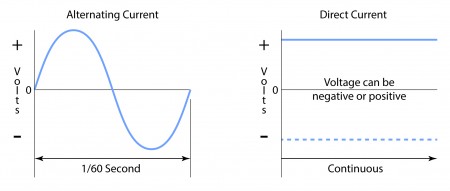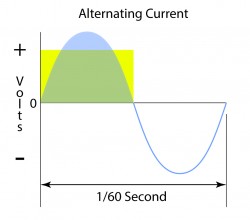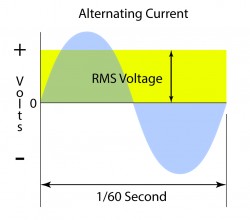Most of us are aware that the power we get from the power line coming into our house or factory comes as alternating current. Basically, the voltage on the “hot” wire as referenced to ground varies, going negative then positive 60 times each second (60 Hz).
The benefit and compelling argument for using alternating current to transmit electrical energy is that it is relatively easy to change the voltage of the alternating current using transformers (which can not be done with direct current). The ability to convert voltage makes it possible to distribute large amounts of electrical power over great distances using conductors of practical size.
Note – The amount of current (amps) that a wire or other conductor can carry without a significant loss of power is determined by its material of construction, size (gauge) and length. Long distance power transmission lines operate at very high voltage to transmit the same amount of power with smaller gauge wires than would be required at a lower voltage.
The RMS voltage of any waveform will produce the same heating effect on a resistive load as if the same direct current voltage were applied to the same resistive load. RMS stands for Root, Mean, Squared. To understand this better, let’s start with the portion of the sinusoidal wave where the voltage is positive. To find the RMS voltage, we would take the voltage at every point and, first, calculate their square roots. Having done this for every point, we would add all of these square roots together and then divide by the total number of points. Finally, we would take the average of the square roots and square it to get the RMS voltage. Of course, this can be done using some simple calculus but I’ll leave that for the math geeks – concept is what we’re going for here. The result of all this effort will give us the RMS voltage. One should not confuse RMS with average voltage which, except for a few special cases, is somewhat skewed from taking the simple average of the voltage over time by the fact that we are going for power, not really voltage, and power includes a squared factor (P=I²R). In the diagram below, the blue area (representing the sinusoidal voltage) will produce the same heating effect in a resistive load as the yellow area which represents the RMS voltage.
Now let’s look at what happens when the sinusoidal voltage goes negative – this is a bit more tricky. The square root of a negative number is, well, difficult. As we all know, if you multiply a negative number by a negative number, the result is always positive – – almost always. Through the magic of mathematics, there are imaginary numbers which are represented by the addition of an i to a number so that, for example, the square root of -2 is 1.414i . Squaring 1.414i gives you 2, not -2. As a result, the RMS value remains positive despite the fact that the voltage is negative for 1/2 of each cycle. This makes sense as the heating effect on a resistor is the same no matter which way the current is flowing.
Finding the RMS voltage of a sinusoidal wave signal is easy because some pretty simple rules apply. The RMS voltage of a sinusoidal is always the peak voltage divided by the square root of 2 (1.414). Yes, this means that the peak voltage of 120 volt RMS power is around 170 volts and that the peak to peak (maximum positive to maximum negative) is 340 volts. And guess what, 340 divided by the square root of 2 is 240! But that’s another blog.
Most of us will never encounter the need to determine the RMS voltage of a waveform other than one that is sinusoidal. But it is important to remember that electrical energy can come in many wave shapes. The simple rules above ONLY apply if the voltage is sinusoidal. In order to accurately determine the RMS voltage of shapes other than those that are sinusoidal (square waves, sawtooth waves and ramp functions, for example) requires different math. Most common meters accurately measure RMS voltage ONLY if the signal is sinusoidal!
– FJF –



 English
English Spanish
Spanish Chinese
Chinese Canada
Canada Mexico
Mexico United Kingdom
United Kingdom






